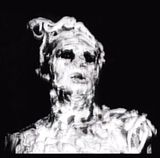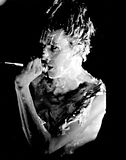1980 also saw a number of live performances, including Fad Gadget’s first forays onto European soil, where a strong and enthusiastic following was beginning to develop, as well as shifts in their line-up which saw the beginnings of a more permanent band emerge. Lederman and Wauquaire were forced to leave through lack of funds, returning to their native Belgium, where several years later Lederman would form The Weathermen with ex-Tuxedo Moon member Bruce Geduldig, the pair of them going on to achieve a German chart hit in 1987 with their single “Poison”. Another of his outfits, Kid Montana, which included Wauquaire amongst its ranks for a while, also achieved a degree of underground success as a result of records released on hip Brussels label Les Disques du Crepuscule. Their places were filled by the likes of Robert Gotobed, moonlighting from his more permanent post behind the drumkit of Wire, and percussionist Nick Cash who had previously played and released records with PragVec and The Lines but who would now stay with Fad Gadget for the duration, and it was members of this evolving line-up, alongside Tovey, Miller and Eric Radcliffe’s sidekick at Blackwing, John Fryer (credited as playing extra fingers, ashtray, metal chair and studio), who spent some of the middle part of the year recording Fad Gadget’s debut album “Fireside Favourites”, released in early November.
A single, “Fireside Favourite”/”Insecticide”, preceded the release of the album by a month or so, however, and proved to be the third classic Fad Gadget 7” in a row. “Fireside Favourite” is a creepy, yet catchy, electro-waltz over which Tovey addresses his sweetheart in loving and coaxing terms, whilst sardonically juxtaposing the warmth and security of the fireside with the disastrous calamity of an impending nuclear holocaust. This was, after all, the autumn of Greenham Common protests over the deployment of American nuclear weapons on British soil and the direct aftermath of Russia’s invasion of Afghanistan, followed by the US’s subsequent boycott of the Moscow Olympics. Tensions were high and expectations were low. However, as with the previous releases, the tone is darkly humorous rather than preachy, the result being another piece of highly individual pop (but not pop), the sing-a-long lyrics taking us from the comfortable image of “toasting crumpets by the fire grate” to a situation whereby, “..your hair is falling out and your teeth are gone, your legs are still together but it won’t long. Your head was on my shoulder. Now, I’m kissing a skull. My heart is melting slowly as my senses dull. Now, we’re just a scab on a piece of wire. All things are done in front of the fire.” As one journalist put it, “Fireside Favourite” is “a song in which somebody’s girlfriend melts in his arms. Literally.” Turn the record over and “Insecticide” is equally ghoulish yet amusing, as we hear the distorted first person narrative of a fly as he creeps up the wall and across the ceiling, spins around a lightbulb and lands on a sandwich. An explanation of his frustration at being stuck in the same room, seemingly forever, and of how he has discussed his death wish with his wife ensues and he then begins smashing his face repeatedly against the windowpane in an attempt to commit hari-kari, all this delivered over a powerful and intense riff which echoes John Carpenter’s music from films such as “Halloween.” As previously, the single fared well critically and in the Independent Charts, Red Starr in “Smash Hits”, again being keen to extol its virtues: “The sadly neglected Fad Gadget looks like he could give The Human League a run for their money in the smart electronic stakes. His third excellent single in a row previews two tracks from his forthcoming album and features more of his clever black humour lyrics and nifty tunes. ‘Fireside Favourites’ pointedly combines the home fire, the atom bomb and an insanely jolly cakewalk while ‘Insecticide’ views life from an insect’s point of view with some clever effects. Highly recommended.”
Then, as mentioned, the debut album came out and “Fireside Favourites” has gone on to become one of Fad Gadget’s most loved releases, as well as one of the most enduring of the first wave of electronic albums then emerging. This, again, though, is probably as a result of Tovey’s uncompromising, somewhat commercially obtuse approach which favoured experimentation over clichéd instantaneity but which, ultimately, denied him the riches enjoyed by a number of his contemporaries. As well as both sides of the most recent single, the album also included amongst its nine tracks a re-recorded version of “The Box” and three other songs from the original demo tape, the infectiously harsh “State of the Nation”, “Salt Lake City Sunday”, which was Tovey’s critique of the mercenary paradox at the core of organised religions ( “They want you to repent. They want your ten percent.”) and the electofunk of “Coitus Interruptus”, a song about people’s failed attempts at having sexual intercourse. As Tovey explained to ZigZag journalist Akiko Hada six months or so after the album’s release, “Because nearly all disco songs seem to be about having sex, I thought why shouldn’t there be a song about not being able to have it?” In addition to this, two of the newer songs, “Pedestrian” and “Newsreel” suggested a somewhat prophetic side to Frank Tovey, as the issues raised seem more contemporary to us now in the twenty-first century than they did in the early 1980s. “Pedestrian” takes as its theme the damaging impact of the increasingly dominant car culture ( “Twenty-five acres every day to make one mile of motorway. Pedestrian wait. Don’t breathe the air it’s full of lead, babies sick, babies dead. Pedestrian wait.”), whilst “Newsreel” exposes the unpalatable voyeurism of reality television ( “Point the camera at the baby. Shoot the mother giving birth. Watch the blood run down the table. Close up to the afterbirth.”). Alongside 1968’s television drama “Year of the Sex Olympics”, the latter serves as a particularly sharp indicator of the unempathetic times lying ahead. The remaining track, “Arch of the Aorta” is an unsettling, atmospheric instrumental with hard to decipher vocal samples, suggesting a hospital operating theatre, woven into the mix.
Although the album was, once again, successful on an Independent Chart level, dissenting voices were beginning to be heard from reviewers, some of them previously enthusiastic in their approval. Red Starr in “Smash Hits”, for example, wrote: “I was a bit surprised by Fad Gadget’s ‘Fireside Favourites’(Mute). There’s been such a buzz about him that I didn’t expect the rather tame Numanisms of the first side. Turn over, though, and you’ll find him recovering much of the lost ground with more original tracks that include a dreamlike trip through major surgery called ‘Arch of the Aorta’ and the comedy of ‘Insecticide’ in which Fad Gadget becomes a housefly who spins round a light bulb prior to landing on your sandwich.” Pete Erskine of ZigZag was equally mixed in his evaluation: “’Ullo, Gary Numan with more balls. Fad Gadget scores over other synth-brigadiers in that there’s a bit more going on in the rhythm. His lyrics are warmer but he’s still guilty of the deep-voice.”

In the same month that the album was released, Fad Gadget played live at The Bridgehouse in London’s Canning Town (11th November 1980), the gig being particularly memorable as it was the occasion on which the teenage support band, Depeche Mode, first came to the attention of Mute Records boss, Daniel Miller, and a highly significant chapter in the history of pop music began to be written. It also sparked a relationship between the band and Frank Tovey which would last right up until his death, more of which later.
Perhaps as a result of comments such as those by Red Starr or maybe simply because a bass player, Pete Balmer, had been temporarily recruited into the ranks, the first release of 1981 represented a bit of a move away from the pure electronics of the previous Fad Gadget releases. “Make Room”, hitting the racks in March of that year, although possessed of a noticeable synthesizer presence, is much more akin to conventional pop and gestures towards a more organic sound, Robert Gotobed’s drumming and Balmer’s prominent bass giving it a rather funk-like feel. Personally, I find it a bit of a disappointment in the aftermath of what had gone before, the fact that it featured Dave Simmonds on synthesizer and Barbara Frost on full backing vocals for the first time being its chief draw, as both went on to be Fad Gadget stalwarts and members of what would ultimately become the settled nucleus of the band. David Hepworth, however, gave the single a favourable review in “Smash Hits”: “Spare, rhythmic and very clever. If Fad is crazy, he’s crazy like a fox and this deserves radio play at the very least.”
The single’s flipside, though, “Lady Shave”, is pure Fad Gadget heaven and was voted amongst his five most popular songs by fans when invited to do so for the “Fad Gadget by Frank Tovey” retrospective in 2006. Another dancefloor favourite, due to its catchy riff and relentless rhythm, the track concerns itself with the social pressures placed upon women to shave certain parts of their bodies in order to be considered beautiful, something Tovey saw as unnecessary and offensive, as he explained to Paul Morley in an NME interview the following year: “I object to the pressures put on people to have hair here but not there...the pressure that says that hair on a certain part of a woman’s body is unfeminine. I don’t think pubic hair is shocking at all. I think it’s quite funny. I can’t understand why pubic hair is supposed to be naughty or shocking. Why there are certain parts of the body that you mustn’t talk about. Why can’t you have your pubic hair coloured and attended to by a hairdresser?” The song, which ends with the sound of running water, in true Fad Gadget fashion, draws a parallel between this everyday domestic act and the horror of the shower scene from “Psycho” to make its point. It also became a memorable favourite during live shows due to the routine Tovey developed for its performance, this often consisting of him covering his head and torso with shaving cream before extracting hairs, first from his head, then from his armpits and, finally, from his pubic region during an instrumental section of the song, the resulting detritus being sprinkled over the heads of those closest to the stage. A few months later, it also gave rise to a famous set of photographs taken in a Liverpool hotel by Anton Corbijn, where Tovey covered himself in shaving foam, such that, when he was captured in dim light against a neutral background, he became transformed into some strange sculptural being. Images from this session then accompanied Paul Morley’s interview in the 23rd January 1982 issue of the NME and resurfaced later to grace the cover of 2001’s compilation of A-sides and B-sides “The Best of Fad Gadget”. Frank Tovey now also went on to become one of Corbijn’s favourite subjects and the photographer most famous for his work with Joy Division, Depeche Mode and the truly awful U2 took many photographs of him over the next couple of years. Speaking after his death, he said: “Frank was full of ideas. Far more than I was in those years because I didn’t trust any of my ideas. I was a very intuitive kind of photographer – I would meet somebody and let the situation somehow dictate the photograph. Frank really had visual ideas – theatrical in a sense.”




No comments:
Post a Comment